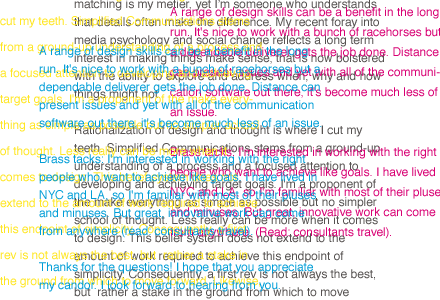The last few posts have found me using imagery to communicate the primary message of the day. Here I'm combining text and imagery to illustrate the complexities of memory. The image that I've created below is representative of the overlapping and constructive nature of human memory. The visual is composed of snatches of notes and cover letters that I've written during my job search.
I've chosen to interlock them using the four process printing colors: cyan, magenta, yellow, and black. Why? Because in a print job, it's necessary to align these colors on different plates to achieve a wide variety of colors with the least number of initial colors. Any lack of printing plate alignment creates a visual dissonance—although sometimes this sort of dissonance is preferable and even delightful to the mind and eye. (Worth remembering!) But here the graphic's koyaanisqatsi-like quality wonderfully captures the confusing and unexpected ways in which human memory works.

We like to think that we have firm, unchangeable memories, particularly for intense events (these are referred to as flashbulb memories). But this is simply not the case. Research has repeatedly shown that our ability to remember something changes from hour to hour, day to day, and dramatically moreso the more time passes. Year to year, decade to decade, the things you think of as unchangeable, morph into varying representational shapes. They are linked and relinked, written and rewritten, saved and resaved each time you attempt to access them. In other words your memory is more like a palimpsest than anything else.
Your memories may be influenced by where you are when you attempt to recollect the past, or what the lighting conditions are as you delve into the past, or even if you're alone or with another person. Here's a hint: You tend to remember things more accurately in the place that you learned or experienced them. It also helps if it's the same time of day with the same weather patterns. (The consideration of accuracy represents a particularly complex area as it's influenced by perception and that in turn is influenced by memory. But that's an entirely different post we'll get to another day.)
Until then, the admonition to keep a diary is a good one. You can use it as a cognitive extension to help you remember your past experiences. You'll be surprised by how often you find yourself surprised upon reading it years later.
As a person looking for work, my identity is in a constant state of flux. How I represent myself shifts around each time I attempt to fashion myself into the most appropriate responder to a listing.
Does this mean that I am prevaricating? Not in the least, I'm merely accenting different aspects of my personality to reflect what others might find particularly important or fascinating. As Walt Whitman wrote, "Do I contradict myself? Very well, then I contradict myself, I am large, I contain multitudes." Along the way, I depend on my holey, inventive memory to reflect my multitudes.